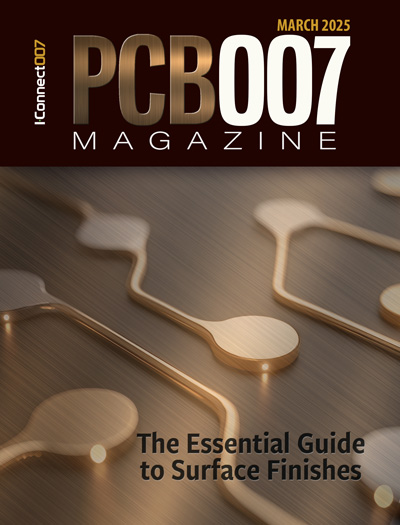-

- News
- Books
Featured Books
- pcb007 Magazine
Latest Issues
Current Issue
In Pursuit of Perfection: Defect Reduction
For bare PCB board fabrication, defect reduction is a critical aspect of a company's bottom line profitability. In this issue, we examine how imaging, etching, and plating processes can provide information and insight into reducing defects and increasing yields.

Voices of the Industry
We take the pulse of the PCB industry by sharing insights from leading fabricators and suppliers in this month's issue. We've gathered their thoughts on the new U.S. administration, spending, the war in Ukraine, and their most pressing needs. It’s an eye-opening and enlightening look behind the curtain.

The Essential Guide to Surface Finishes
We go back to basics this month with a recount of a little history, and look forward to addressing the many challenges that high density, high frequency, adhesion, SI, and corrosion concerns for harsh environments bring to the fore. We compare and contrast surface finishes by type and application, take a hard look at the many iterations of gold plating, and address palladium as a surface finish.
- Articles
- Columns
Search Console
- Links
- Media kit
||| MENU - pcb007 Magazine
Solder Paste Printing From the Stencil’s Perspective
February 19, 2020 | I-Connect007 Editorial TeamEstimated reading time: 22 minutes
Johnson: Do you see good progress being made by solder paste manufacturers to help alleviate some of these challenges?
Schake: It’s difficult for me to judge progress because I’ve been so focused on printing and less aware of the reflow side of things. This aspect of paste performance has come as a little bit of a surprise, especially when facing air reflow requirements for these tiny deposits. I was thinking that it wasn’t going to be a problem, and I’ve found that it is, even using solder pastes recommended for fine pitch printability and air reflow capability. There’s still soldering issues that I was hoping wouldn’t exist, even on highly solderable gold pads that I know are clean.
Johnson: This fits with the industry dynamics right now, from a larger scope. We have automotive, autonomous vehicles, medical devices, and IoT. These markets project devices that will be very small, use very small components, and manufactured in huge quantities with a requirement that they are an order of magnitude or two more reliable than devices are now. This all points to the solder joint as a critical factor.
Schake: Absolutely.
Holden: What’s your background or take on the flex circuit assembly solder pasting? Especially because the flex circuit is still one of the fastest-growing segments of the interconnect market.
Schake: We’re almost approaching flex-like substrates in standard PCBs now. These high-speed printing machines and assembly lines, which are legacy designed for rigid circuit boards, have to accommodate the future of these thinner substrates that are flex like. All equipment manufacturers have to take that into account. How do we prepare ourselves to accommodate this? In many cases, each of these flex-like substrates is attached to its own local support carrier and conveyed through the line in this format. Can we do this somehow without having to palletize everything that goes through the line?
Holden: Because we were making the flex circuits, we could take advantage of the panelized flex, and some of the tooling that went into making and fabricating the flex circuits could then also be used for the assembly. But it was always a fight and always a headache.
Schake: I’m all in on that! It’s rare that I hear about running anything panelized, let alone panelized flex. You did well to take advantage of it. Custom fixturing is indeed a headache.
Matties: What advice would you offer for a designer?
Schake: One of the things that commonly gets overlooked is solder mask. What is the design of your solder mask? What is the spacing of the solder mask from the pad border? How much of a gap do you have between it? How thick is the solder mask relative to the pad? Is it a solder mask defined pad, or a non-solder mask defined pad? Because all of those factors will have an impact on what stencil aperture size you can use. Based on the stencil thickness you have and the pitch, you could have an issue with area ratio, which could possibly challenge the transferability of the solder paste.
The other aspect of solder mask is that it is a topographical feature on the circuit board. Depending on how that’s designed, what the registration of that is, and how close it is to the pad, it’s going to impact the way the stencil gaskets to the circuit board. Solder mask is only one PCB design variable of many. Another one could be legend outlines. The ink marking around a component or around pads. I’m not a fan of legend ink because it tends to raise the level of the stencil in locally affected areas when the stencil is contacting against the board. If that legend ink is close enough to the pad, then the aperture is not going to seat itself properly onto the pad. You’re going to get a bad print.
Matties: That’s probably something people rarely think about.
Schake: Within the IPC 5-21e stencil guideline committee group, we certainly have discussed this, but you’re right; normally, people aren’t thinking along those lines.
Johnson: Because you didn’t have to before, but now we’re down to dimensions where we’re starting to worry about the metal grain in the stencil itself and counting the balls. All of a sudden, the raised dimension of the legend starts to make sense. We’re in the place where that’s no longer noise.
Matties: For the finer pitch conversation, we probably should be talking to some solder mask vendors, and look at the process of applying solder masks. As you’re saying, it’s got to be good coming in before it’s going to be good going out.
Johnson: I hadn’t considered the fact that a solder mask needs to be particularly cleaner.
Schake: I would prefer it. It would help with printing. I know there’s a difference in specifying solder mask technology when we order our test boards. You have LPI, which is “liquid photo imageable.” Then you have LDI, which is “laser direct imaged” solder mask. On some of our test boards that we use for printing, the LPI solder mask, particularly with the fine-pitch printing capability, is not a good combination. LDI solder mask is a much higher quality and a more accurate and controlled result. However, there’s a pretty wide variety of capability out there, even within the scope of LDI solder mask products that we’ve seen.
Matties: Back to what you were saying about the designer, that’s something that they would have to specify if they’re working on a difficult or a fine pitch board. They need to be aware of the impact of the mask as well when they’re making that choice, not driven by how much it costs.
Schake: Right. It can be a deal-breaker if you’re trying to print something that’s challenging. If you have solder mask thickness variation or solder mask misregistration, that can wreak havoc on your printability.
Matties: Especially at the tolerances that you’re talking about.
Holden: A lot of people are adding inkjet solder mask.
Schake: I’m not familiar with that, but it wouldn’t surprise me.
Holden: The inkjet solder mask is catching on pretty quickly.
Matties: It’s been around for years, but now it’s an overnight success.
Holden: The interesting thing is they’re changing all the design rules and using inkjet to outline parts. The solder mask isn’t continuous anymore, which is going to be interesting, because people forget to include it in their impedance calculation the fact that solder mask is a dielectric.
Matties: Jeff, we appreciate your time. Thank you.
Johnson: This has been extremely insightful.
Schake: I’m glad. Take care.
Page 3 of 3Suggested Items
Preventing Surface Prep Defects and Ensuring Reliability
06/10/2025 | Marcy LaRont, PCB007 MagazineIn printed circuit board (PCB) fabrication, surface preparation is a critical process that ensures strong adhesion, reliable plating, and long-term product performance. Without proper surface treatment, manufacturers may encounter defects such as delamination, poor solder mask adhesion, and plating failures. This article examines key surface preparation techniques, common defects resulting from improper processes, and real-world case studies that illustrate best practices.
Breaking Silos with Intelligence: Connectivity of Component-level Data Across the SMT Line
06/09/2025 | Dr. Eyal Weiss, CybordAs the complexity and demands of electronics manufacturing continue to rise, the smart factory is no longer a distant vision; it has become a necessity. While machine connectivity and line-level data integration have gained traction in recent years, one of the most overlooked opportunities lies in the component itself. Specifically, in the data captured just milliseconds before a component is placed onto the PCB, which often goes unexamined and is permanently lost once reflow begins.
BEST Inc. Introduces StikNPeel Rework Stencil for Fast, Simple and Reliable Solder Paste Printing
06/02/2025 | BEST Inc.BEST Inc., a leader in electronic component rework services, training, and products is pleased to introduce StikNPeel™ rework stencils. This innovative product is designed for printing solder paste for placement of gull wing devices such as quad flat packs (QFPs) or bottom terminated components.
See TopLine’s Next Gen Braided Solder Column Technology at SPACE TECH EXPO 2025
05/28/2025 | TopLineAerospace and Defense applications in demanding environments have a solution now in TopLine’s Braided Solder Columns, which can withstand the rigors of deep space cold and cryogenic environments.
INEMI Interim Report: Interconnection Modeling and Simulation Results for Low-Temp Materials in First-Level Interconnect
05/30/2025 | iNEMIOne of the greatest challenges of integrating different types of silicon, memory, and other extended processing units (XPUs) in a single package is in attaching these various types of chips in a reliable way.


